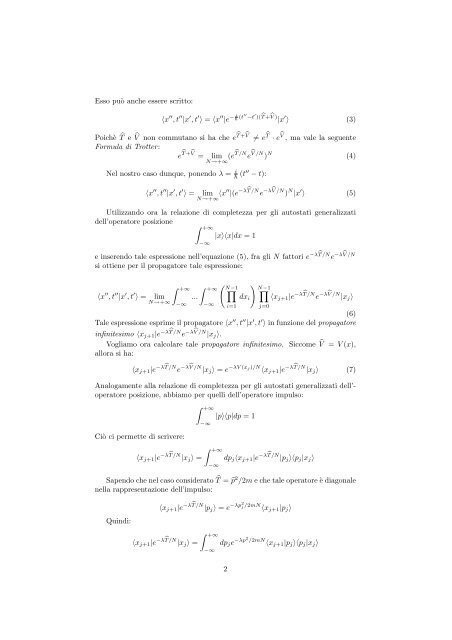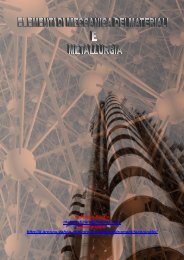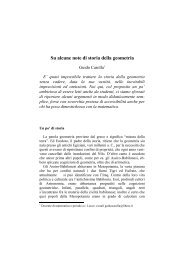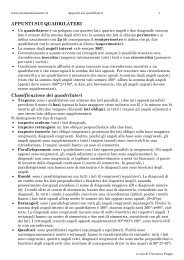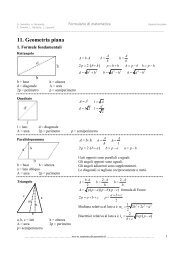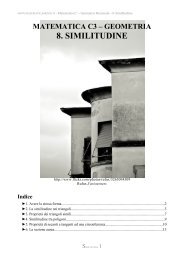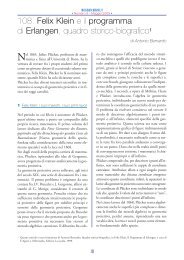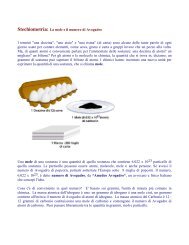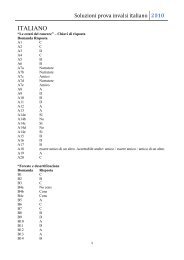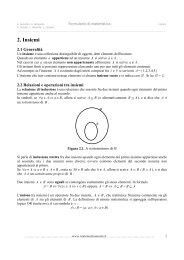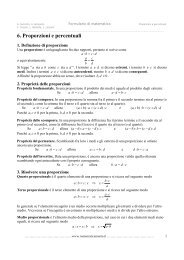Scarica la tesi Integrale di Feynman sui Cammini e Processi Stocastici
Scarica la tesi Integrale di Feynman sui Cammini e Processi Stocastici
Scarica la tesi Integrale di Feynman sui Cammini e Processi Stocastici
Create successful ePaper yourself
Turn your PDF publications into a flip-book with our unique Google optimized e-Paper software.
Esso può anche essere scritto:<br />
〈x ′′ , t ′′ |x ′ , t ′ 〉 = 〈x ′′ i −<br />
|e ¯h (t′′ −t ′ )(T +V ) ′<br />
|x 〉 (3)<br />
Poichè T e V non commutano si ha che e T +V = e T · e V , ma vale <strong>la</strong> seguente<br />
Formu<strong>la</strong> <strong>di</strong> Trotter:<br />
(4)<br />
e T +V = lim<br />
N→+∞ (eT /N e V /N ) N<br />
Nel nostro caso dunque, ponendo λ = i<br />
¯h (t′′ − t):<br />
〈x ′′ , t ′′ |x ′ , t ′ 〉 = lim<br />
N→+∞ 〈x′′ |(e −λT /N e −λV /N ) N |x ′ 〉 (5)<br />
Utilizzando ora <strong>la</strong> re<strong>la</strong>zione <strong>di</strong> completezza per gli autostati generalizzati<br />
dell’operatore posizione<br />
+∞<br />
−∞<br />
|x〉〈x|dx = 1<br />
e inserendo tale espressione nell’equazione (5), fra gli N fattori e−λT /N −λV /N e<br />
si ottiene per il propagatore tale espressione:<br />
〈x ′′ , t ′′ |x ′ , t ′ +∞<br />
〉 = lim<br />
N→+∞ −∞<br />
...<br />
+∞<br />
−∞<br />
<br />
N−1 <br />
i=1<br />
<br />
N−1 <br />
dxi<br />
j=0<br />
〈xj+1|e −λT /N e −λV /N |xj〉<br />
(6)<br />
Tale espressione esprime il propagatore 〈x ′′ , t ′′ |x ′ , t ′ 〉 in funzione del propagatore<br />
infini<strong>tesi</strong>mo 〈xj+1|e −λT /N e −λV /N |xj〉.<br />
Vogliamo ora calco<strong>la</strong>re tale propagatore infini<strong>tesi</strong>mo. Siccome V = V (x),<br />
allora si ha:<br />
〈xj+1|e −λT /N e −λV /N |xj〉 = e −λV (xj)/N 〈xj+1|e −λT /N |xj〉 (7)<br />
Analogamente al<strong>la</strong> re<strong>la</strong>zione <strong>di</strong> completezza per gli autostati generalizzati dell’operatore<br />
posizione, abbiamo per quelli dell’operatore impulso:<br />
Ciò ci permette <strong>di</strong> scrivere:<br />
+∞<br />
−∞<br />
|p〉〈p|dp = 1<br />
〈xj+1|e −λT /N +∞<br />
|xj〉 = dpj〈xj+1|e<br />
−∞<br />
−λT /N |pj〉〈pj|xj〉<br />
Sapendo che nel caso considerato T = p 2 /2m e che tale operatore è <strong>di</strong>agonale<br />
nel<strong>la</strong> rappresentazione dell’impulso:<br />
Quin<strong>di</strong>:<br />
〈xj+1|e −λT /N |pj〉 = e −λp2<br />
j /2mN 〈xj+1|pj〉<br />
〈xj+1|e −λT /N +∞<br />
|xj〉 = dpje<br />
−∞<br />
−λp2 /2mN<br />
〈xj+1|pj〉〈pj|xj〉<br />
2


